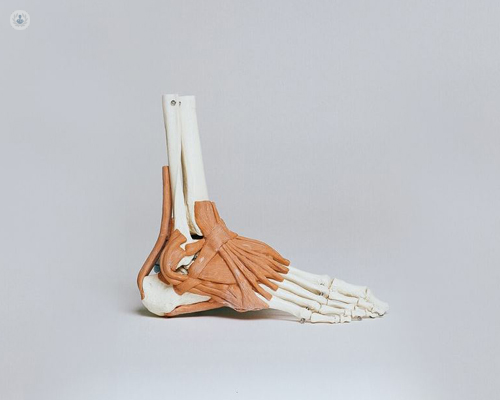How to know if your ankle injury needs medical help: what to expect from diagnosis, treatment and recovery
Escrito por:One of the most common complaints of an ankle injury is the impatience to get moving again. To get back to activity, you’ll need to correctly take care of your ankle and this might require medical help. Mr Billy Jowett clarifies the signs that you need medical help for your ankle injury, what to expect during diagnosis, the treatment you might have, and the recovery time you could need before getting back to activity.

What are common and uncommon ankle injuries?
The most common ankle injuries I see are:
- natural ligament injury
- osteochondral injury (when the cartilage covering a bone is torn or fractured)
- ankle fractures
- cartilage defects
Then there are less common ankle injuries:
- tendon injuries, also known as tendinopathies
- dislocations
- uncommon fractures on specific bones
What signs suggest medical help is needed for an ankle injury?
I’d suggest you visit your local A&E department if you are unable to bear weight on the injured ankle and/or there is severe swelling. Also, consider if there is an unusual intensity of sprain. People might think that they have a low-grade sprain that doesn’t require medical assistance but in reality, the damage is more significant. An ankle sprain that stays painful and that doesn’t settle after six weeks to three months should be looked at by a medical professional.
Sometimes, it’s obvious that a visit to A&E is required. This involves trauma (high-energy injuries) e.g. when there has been a significant force through the ankle due to falling from a significant height or at speed. Generally, a sprain from walking is less likely to need emergency help than falling from a ladder.
If your symptoms are mild and you’re unsure about the severity of your ankle injury, you can still receive an expert opinion. For example, I have three private clinics where each week I see patients who have a less urgent injury as well as patients with urgent ankle injuries.
How does a specialist diagnose an ankle injury?
We (orthopaedic specialists) take several steps to diagnose an ankle injury. These involve taking a history of the patient’s health, performing a clinical examination and carrying out a specialist investigation with tools such as an MRI scanner and/or X-ray scanner. Usually, patients will have the first appointment and then, if further investigations are needed, a separate appointment for scans. Then, there will be a follow-up appointment.
What non-surgical treatment can be used for ankle injuries?
Physiotherapy is vital for patients when it comes to recovering their proprioception (the body’s ability to balance and perceive its positioning and spatial-awareness). Bracing the ankle is another non-surgical method of alleviating pain while the ankle injury heals itself, as well as applying ice to help with swelling and pain.
When is surgery needed to treat ankle injuries?
Some ankle fractures need to be surgically fixed if they’re unstable or displaced. Surgery will be required if physiotherapy hasn’t worked, if pain persists, and if the ankle remains unstable.
Can people still compete in athletics after an ankle injury?
When it comes to the average ankle sprain, patients can start participating in activity as soon as two weeks post-injury. Sometimes, the more general rule is to wait six weeks for a standard ankle sprain. In some cases, your specialist might recommend waiting three months before starting to compete again. If you have surgery, when you can return to competing depends on the type of surgery you’ve had. However, a general recommendation is to wait six months before returning to activity.
Whether you’ve had surgery or not, make sure to check with your specialist for a personalised evaluation of when you can return to activity.
Do you have concerns about your foot and ankle? For specialist advice and treatment, visit Mr Jowett’s profile and get in touch.


